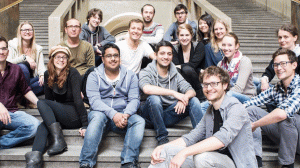Nearly three months ago, we decided to do something we've been talking about for years. We went remote.
Our reasons for doing so were numerous, both personal and pragmatic. As an international team and globally-minded individuals, our lives were quite simply calling us to different (physical) places. Flexibility and a global mindset were always strong personal values shared and lived by our team. As tbd* approached its 6th year, it seemed only natural that we allow ourselves as individuals to pursue opportunities outside of Berlin that help us grow, learn, and thrive as much as the company has since its creation in 2014.
- Remote Work:
- As younger generations enter the workforce, their values are pushing companies to adopt more flexible working policies, including the possibility to work outside the office. Whether from home office or a coworking space, businesses are adopting new work policies that allow at least a partial telecommute.
The other reasons were more ideological. As purveyors of new work, it seemed this was an opportunity to walk the walk and not just talk the talk. We were already in the midst of a change management process and it seemed the timing was right to trial a new way of working. Home office was already a well established ritual within the company. In fact, there were days where no one was in the office, or just one or two people came in, making the office feel somewhat empty and unloved. Did it make sense to continue hanging on to a model of work that no longer seemed to suit the needs of our team? If we as a company couldn’t try something new by tossing out the traditional idea of how or where we’re supposed to work, could we really stand by our ideals of workplace changers? The answer was no.
And we’re clearly not alone in our thinking. Remote work is expected to grow, in fact, the numbers indicate that we are nowhere close to hitting the plateau. As Gen Z enters the workforce, their values will push more businesses towards adopting more flexible working policies and allowing at least partial telecommute.
That said, we didn’t entirely peace out from one day to the next. In fact, it was a rather slow, and, in retrospect, organic process. In the past, we’d had a remote policy where individuals could work remotely for a longer period of time. We’d had team members go to South Africa, the USA, the Philippines, Spain, a bus in Brandenburg… In this trial phase, we learned a valuable lesson; when some people are in the office and some are not (regardless of whether they are in Neukolln or Timbuktu), things get lost in translation. As it turns out, it’s easier to communicate effectively when everyone is either in the office or not. Therefore, when it became apparent that some of us would no longer be in Berlin, the natural solution was to make the switch to an entirely remote company. It is important to note that we are not now “digital nomads” who are constantly jetting around the world, but rather we have permanently relocated in different places. We are very conscious about our flight miles and always take alternative transport (when possible and where necessary) and combine appointments in order to limit travel. When we do have to fly for business, we’ve introduced a company policy of compensating our CO2 emissions.
[recommended:9695]
By going remote, we could access a greater (international) talent pool, gain personal flexibility to travel or live elsewhere, get rid of the overhead cost of an office, reduce commuting times and maybe even lower our carbon footprint. But with all the gains there was also a lot to lose. Without team lunches, company drinks, or impromptu chats at the coffee machine, would we lose that personal connection to one another? What about our connection to our community? Would team communication suffer and lead to general chaos? Three months in, we’ve settled into our groove and we’d like to share some of our initial learnings and reflections with all of you.
Well Structured
The first step was ensuring that we had a robust structure that could withstand distance and was optimized for the digital zone. For now, we’ve settled on the following meeting structure.
- Daily meetings: These are quick check-in meetings, lasting no more than 15-20 minutes, where we catch up on both work and non-work related topics. From sharing weekend anecdotes to asking urgent questions about projects, this is the space for chitchat and quick updates.
- Weekly meeting: Once a week, we have a longer team meeting (1 hour) where decisions are made and additional information sharing takes place.
- Team coaching: Every two weeks, we have a team coaching session with an external coach. We realized that communicating in a purely digital space can be challenging as it’s harder to read body language and physical cues. Misunderstandings can happen via email or chat, where tone is harder to interpret. This space allows us to discuss any issues that may have come up, ensuring that time and space is given for deeper communication and overall team wellbeing.
- Bi-quarterly team meeting: Every two months, we get together for a larger strategy session, which includes a review of the previous two months and planning for the upcoming months. Every other meeting is held face-to-face and ample time is planned for team building activities. Later this month, we’ll be gathering in Berlin for our team strategy days.
Given that we have already worked with home office and had dabbled in remote work, a lot of the digital tools needed for remote work were already in place. Therefore the transition felt relatively smooth. Companies that don’t already practice home office or remote work might struggle more. We use Slack as a primary tool for team communication, different Slack channels help us stay organized and allow for a bit of chatting and banter throughout the workday. Zoom has been great for video conferencing, while Trello is our trusty project management tool. In the years prior, we invested in setting up a knowledge management system where we can all access company documents and materials. Even with all the planning, there have been unforeseen challenges that came up along the way. Like everything, it’s been a learning process and one that we’re constantly adjusting.
Lessons Learned
With the nitty-gritty squared away, it was time to jump in. What would it actually feel like? None of us were sure. Would it be terribly lonely? The freedom we’d all been dreaming of? As it turns out, it’s not entirely that black and white. And, as a surprise to no one, while there is a shared collective team experience, it’s also greatly depends on the individual.
So what was the biggest surprise? Believe it or not, team communication has actually improved since we started working remotely.
“We communicate more regularly, at greater length, more deeply and laugh more than we often did when we were sharing an office.”
“I was afraid I would feel alienated from my colleagues, because we no longer see each other “physically” every day. However, it is rather the opposite. We have a video conference every day and since everyone is concentrated and focused in it, the contact has become more intense.”
What have we gained from remote work? Time and flexibility, resulting in an improved overall quality of life.
“I used to spend up to two hours a day on public transport. Those two extra hours of not squeezing into the subway/making sure nobody accidentally steps on my dogs tail really has improved my quality of life.”
It has also certainly allowed us greater freedom. One of us is currently living in Stockholm, another in a cabin on the coast of Maine. The ability to visit friends and family, while working, certainly feels luxurious.
“What do I like best about remote work? The freedom to go or stay wherever I want. For example, I am currently traveling through Germany, the Netherlands and Belgium via train to meet friends I haven’t seen in a while. I am simply taking my work with me.”
As suspected, and slightly feared, isolation has been one of the greatest challenges thus far. For many of us, our workplace serves has our main space for social interaction. In an increasingly lonely world, what happens when we take that out of the equation? Feelings of isolation have been proven to be a challenge with the team thus far. And we’re not alone. According to Forbes, the biggest reported struggle of remote work is lack of community - 21% of remote workers named “loneliness” as one of their main on-the-job issues.
“I miss the little conversations in between, as well as having lunch together. We try to bridge that with digital team meetings and a daily 20 minute call in which we can chit chat, exchange ideas and ask questions. It helps, but still isn’t the same as meeting in person…. It’s sad to sit alone at home all day, not seeing other people.”
On the other hand, for some of us, removing the physical office space has allowed us to pursue more social contact outside of work.
“I thought the remote work would make me a hermit. But strangely enough exactly the opposite has happened. I have much more energy at my disposal and I meet more people for lunch or after work than before.”
“I have noticed that I need to make more of an effort to socialize now. It doesn’t just happen automatically in the office. That said, I feel like I reach out to people with more intention and am more present/joyful in the social interactions I seek out.”
Another challenge has been switching off from work, particularly when not in a co-working space. When home is our office, the lines between being “on” and “off” are easily blurred; one last email, breakfast in front of the laptop, or even just a mind that can’t switch off because there is no physical distance between home and work. Three months in, some have found that working from home simply doesn’t work for them.
The co-working space has been a welcome solution to both aforementioned challenges. Currently nearly everyone in the team is working in a co-working space. This helps fill the social gap and creates a designated work space, allowing for greater separation between home and work.
What’s the verdict?
When we told our investors, parents, and professional contacts that we were going remote, we were met with a fair amount of concern and skepticism. The underlying question being, will it work? So far, the answer seems to be yes. Business wise, we’ve seen little fluctuation since we’ve decided to go remote. That said, it’s been a relatively short amount of time and as far as the long-term implications go, it may be too soon to tell. Sure, there are some obvious gains - no long commutes, flexibility to travel (consciously!) and work from anywhere - but do these gains come at a human expense? The verdict is still out. Stay tuned...










